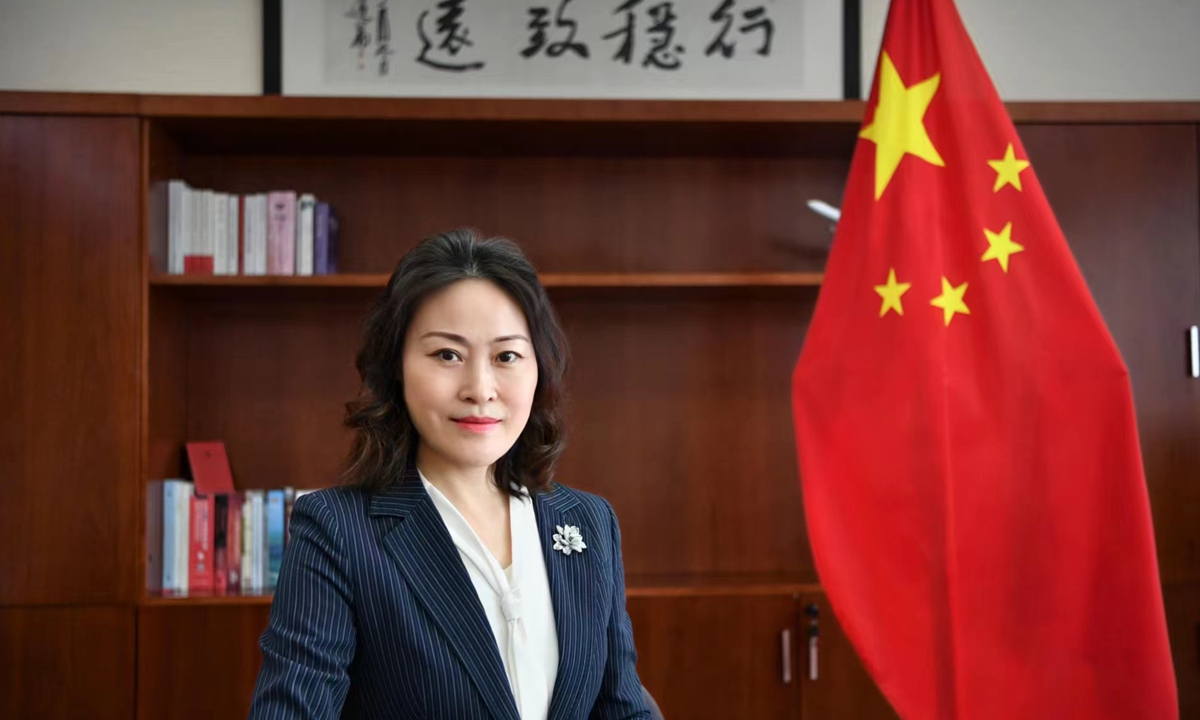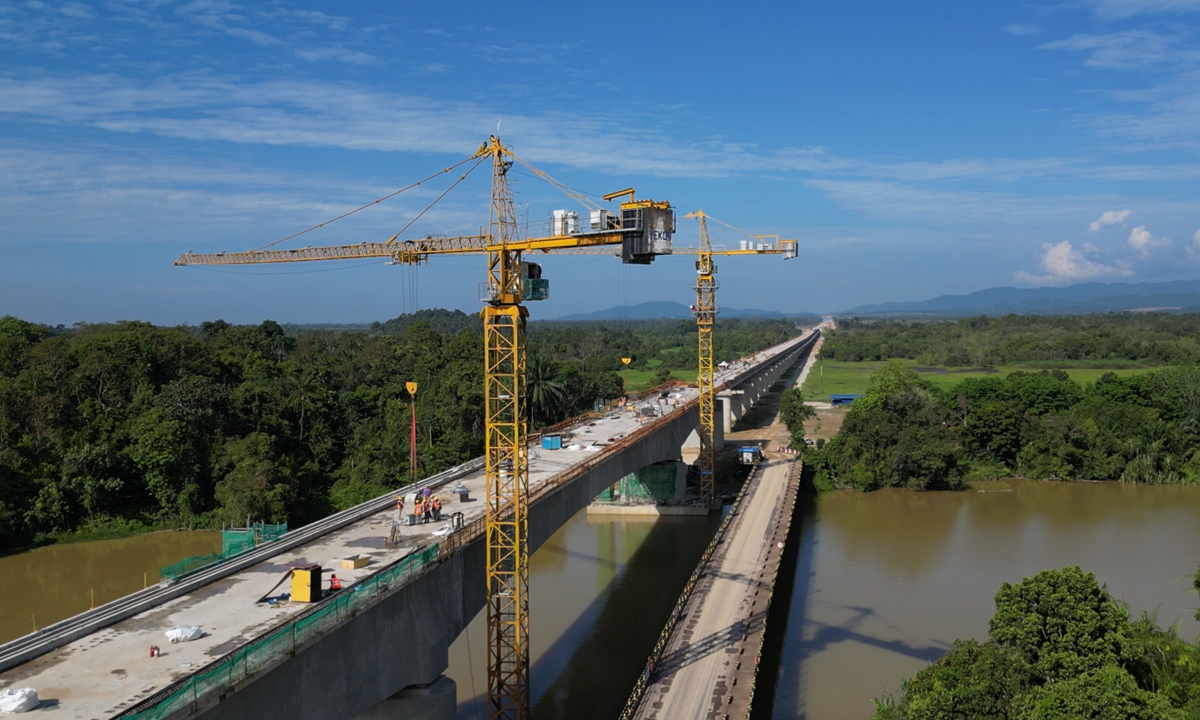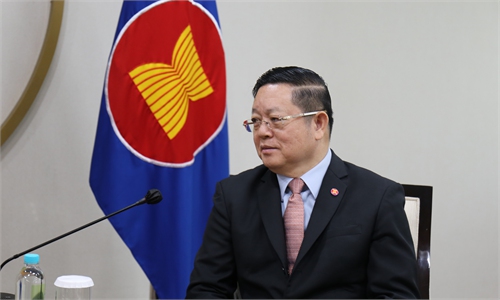IN-DEPTH / DIPLOMATIC CHANNEL
China-ASEAN consensus has brought tangible benefits to 2 billion people, withstood multiple tests: Chinese Ambassador to ASEAN
Common development
Editor's Note:
Relations between China and the ASEAN have continued to improve since the establishment of ASEAN-China Dialogue Relations in 1991. Over the last 30 years, the China-ASEAN relationship has achieved remarkable development and brought about tangible benefits for more than 2 billion people in 11 countries. China and the ASEAN have pursued the right path of long-standing good-neighborliness and friendship, and common development and prosperity. Recently, Global Times reporters Hu Yuwei, Zhao Juecheng, and Li Xuanmin (GT) interviewed Chinese Ambassador to the ASEAN, Hou Yanqi (Hou), in Indonesia, to get more insights from her on the future pathway of China-ASEAN political and economic relations.

GT: China has signed bilateral cooperation agreements on jointly building the Belt and Road Initiative (BRI) with all 10 ASEAN member states. Over the last 10 years, the ASEAN has been a priority direction and important partner in promoting the BRI. What do you think are the important reasons for the ASEAN's significant achievements in the BRI?
Hou: The ASEAN, as the priority direction and important partner in the co-construction of the BRI, has achieved fruitful cooperation results in the last 10 years. I believe there are several important reasons for this.
First, China and the ASEAN are connected by mountains and rivers, and have a close relationship. They are also comprehensive strategic partners, with solid political and public support for cooperation in various fields.
Second, we have been adhered to the principles of "consultation, co-construction, and sharing," and have promoted development through openness and achieved win-win outcomes. We have achieved complementary advantages in the high-quality construction of the BRI.
Third, we are both determined actors with visions. We prioritize commitments and implementation, ensuring that the achievements of the BRI are tangible and substantial.
The ASEAN has a superior geographical location and plays an important role in regional economic cooperation. But it also faces development bottlenecks such as insufficient infrastructure investment and relatively lagging regional connectivity. The implementation of the BRI has played an important role in breaking these bottlenecks and fully unleashing the development potential of the ASEAN.
China and the ASEAN have signed cooperation documents on aligning the BRI with the Master Plan on ASEAN Connectivity 2025, thus achieving full consensus on regional connectivity in top-level design. Moreover, BRI effectively fills the funding gap in ASEAN countries' infrastructure construction in areas such as rail, roads, bridges, and ports.
GT: Looking back at the 30-year development of China-ASEAN relations, each time a regional or global crisis occurs, the momentum of cooperation between the two sides becomes stronger and political mutual trust steadily increases. How do you think this enhanced political mutual trust can further strengthen ties? What new positive perspectives can the China-ASEAN cooperation bring to global peace, security, and development?
Hou: Over the last 30 years, China and the ASEAN have established a dialogue relationship that has withstood multiple tests. Political mutual trust between the two sides has continued to increase.
We are pleased to see that the positioning of the bilateral relationship has evolved from a partnership of good neighborliness and mutual trust to a strategic partnership, and finally to a comprehensive strategic partnership established in 2021, achieving leapfrog development.
China and ASEAN countries are actively implementing the consensus reached by their leaders, moving forward along the path of good neighborliness, friendship, and common development, bringing tangible benefits to more than 2 billion people in 11 countries.
Currently, amid an increasingly unstable international and regional situation, China and the ASEAN, as emerging economies, share many common interests in global peace and development.
Both sides advocate for dialogue to manage differences and conflicts, uphold true multilateralism and open regionalism and work together to address regional and global challenges. Both sides also promote regional economic integration to facilitate common development and maintain stable supply chains.
In conclusion, China and the ASEAN are contributors to regional and global peace and security, as well as promoters of development and prosperity.

Hou: The China-ASEAN FTA was launched in 2002, making it China's first free trade area negotiated with a foreign country and ASEAN's first free trade area negotiated as a whole. Over the last 20 years, the China-ASEAN FTA has effectively promoted the rapid growth of trade and investment between China and the ASEAN, and the socio-economic development of both sides.
As of 2022, China became the ASEAN's largest trading partner for 14 consecutive years, and the ASEAN has been China's largest trading partner for three consecutive years.
Compared with versions 1.0 and 2.0, version 3.0 will further reduce tariff and non-tariff barriers, promote freer and more convenient trade and investment, and explore strengthened cooperation in new areas such as the digital economy, the green economy, and supply chain interconnectivity, further promoting regional economic integration.
In recent years, as both China and the ASEAN have undergone upgrading in their economies, new trends are emerged. For example, cooperation in the digital economy and green economy is flourishing, becoming important engines driving regional economic growth. China has advantages in digital economy platform construction, as well as in capital, and technology, seeing an unlimited potential for cooperation in digital transformation.
The same is true for cooperation in the green economy. I am pleased to see more Chinese new energy companies investing in Southeast Asia, which will create new momentum for the upgrading of China-ASEAN economic and trade cooperation.
GT: Currently, the Regional Comprehensive Economic Partnership (RCEP) is in effect in all 15 signatory countries, marking a new phase of comprehensive implementation for the world's largest free trade area. With the full implementation of this agreement, how will it promote trade between China and the ASEAN region?
Hou: The RCEP is a global free trade area with a total population of nearly 2.3 billion, a GDP of $26 trillion, and a trade volume exceeding $10 trillion. It is a significant achievement in the construction of Asia-Pacific regional economic integration and a vivid example of regional countries sharing development opportunities.
The commitments to open markets for goods, services, and investment by the 15 parties, combined with high-level rules in various fields, will greatly promote the free flow of production factors such as raw materials, products, technology, talent, capital, information, and data within the region, and gradually create a more prosperous integrated regional market.
It can be said that the comprehensive implementation of the RCEP not only creates more favorable conditions for China and the ASEAN to expand trade in goods, but also drives corresponding trade in services, promoting trade facilitation, and improving the business environment.
China will work together with the ASEAN and other RCEP members to continuously promote the high-quality implementation of the RCEP and make greater contributions to regional and global economic recovery.
GT: What significant outcomes do you think were achieved at the China-ASEAN Foreign Ministers' Meeting held in Indonesia in July? Wang Yi, director of the Office of the Foreign Affairs Commission of the Communist Party of China Central Committee, also Minister of Foreign Affairs, emphasized at the meeting that regional countries must guard against three negative trends concerning peace and security in the region. How do you think efforts should be made to suppress these negative trends?
Hou: The ministers' meeting in Indonesia achieved significant positive outcomes.
First, the joint statement commemorating the 20th anniversary of China's accession to the Treaty of Amity and Cooperation in Southeast Asia (TAC) was adopted, reaffirming the principles of independence, sovereignty, equality, non-interference, and the peaceful settlement of disputes.
Second, the second reading of the Code of Conduct in the South China Sea (COC) text was successfully completed, and the guidelines for expediting the conclusion of the COC were adopted, creating conditions for the prompt initiation of the third reading and taking an important step toward its finalization.
In recent years, amidst the impact of the global pandemic and interference from external forces, these achievements have been hard-won. It sends a clear signal to the outside world that China and ASEAN countries have the ability and wisdom to handle the South China Sea issue through joint efforts, making it a sea of peace, friendship, and cooperation.
Third, comprehensive and pragmatic cooperation has continued to advance, including the promotion of negotiations on upgrading the China-ASEAN FTA.
Regarding the second question, I believe the three proposals put forward by Wang Yi at the ministers' meeting are the answer to restraining these three negative trends.
First, it is to effectively support the central role of the ASEAN and consolidate the foundation of peace. We should resolutely oppose the acts of certain countries forming cliques, creating new blocs, and pushing for NATO's involvement in East Asia, and truly uphold the maximum common denominator of the ASEAN centrality position.
Second, it is to work together to build a center of regional growth, continuously advance the construction of the Asia-Pacific FTA, and oppose protectionism, decoupling and disengagement.
Third, it is to adhere to true multilateralism. We should uphold the purposes and principles of the TAC, adhere to the "ASEAN principles" of mutual respect, non-interference in internal affairs, and the proper handling of differences through dialogue and consultation, practice open regionalism and genuine multilateralism, abandon the mentality of binary confrontation, and replace conflict with dialogue and cooperation.
Relations between China and the ASEAN have continued to improve since the establishment of ASEAN-China Dialogue Relations in 1991. Over the last 30 years, the China-ASEAN relationship has achieved remarkable development and brought about tangible benefits for more than 2 billion people in 11 countries. China and the ASEAN have pursued the right path of long-standing good-neighborliness and friendship, and common development and prosperity. Recently, Global Times reporters Hu Yuwei, Zhao Juecheng, and Li Xuanmin (GT) interviewed Chinese Ambassador to the ASEAN, Hou Yanqi (Hou), in Indonesia, to get more insights from her on the future pathway of China-ASEAN political and economic relations.

Hou Yanqi, Chinese Ambassador to ASEAN Photo: Courtesy of Chinese Embassy to ASEAN
GT: China has signed bilateral cooperation agreements on jointly building the Belt and Road Initiative (BRI) with all 10 ASEAN member states. Over the last 10 years, the ASEAN has been a priority direction and important partner in promoting the BRI. What do you think are the important reasons for the ASEAN's significant achievements in the BRI?
Hou: The ASEAN, as the priority direction and important partner in the co-construction of the BRI, has achieved fruitful cooperation results in the last 10 years. I believe there are several important reasons for this.
First, China and the ASEAN are connected by mountains and rivers, and have a close relationship. They are also comprehensive strategic partners, with solid political and public support for cooperation in various fields.
Second, we have been adhered to the principles of "consultation, co-construction, and sharing," and have promoted development through openness and achieved win-win outcomes. We have achieved complementary advantages in the high-quality construction of the BRI.
Third, we are both determined actors with visions. We prioritize commitments and implementation, ensuring that the achievements of the BRI are tangible and substantial.
The ASEAN has a superior geographical location and plays an important role in regional economic cooperation. But it also faces development bottlenecks such as insufficient infrastructure investment and relatively lagging regional connectivity. The implementation of the BRI has played an important role in breaking these bottlenecks and fully unleashing the development potential of the ASEAN.
China and the ASEAN have signed cooperation documents on aligning the BRI with the Master Plan on ASEAN Connectivity 2025, thus achieving full consensus on regional connectivity in top-level design. Moreover, BRI effectively fills the funding gap in ASEAN countries' infrastructure construction in areas such as rail, roads, bridges, and ports.
GT: Looking back at the 30-year development of China-ASEAN relations, each time a regional or global crisis occurs, the momentum of cooperation between the two sides becomes stronger and political mutual trust steadily increases. How do you think this enhanced political mutual trust can further strengthen ties? What new positive perspectives can the China-ASEAN cooperation bring to global peace, security, and development?
Hou: Over the last 30 years, China and the ASEAN have established a dialogue relationship that has withstood multiple tests. Political mutual trust between the two sides has continued to increase.
We are pleased to see that the positioning of the bilateral relationship has evolved from a partnership of good neighborliness and mutual trust to a strategic partnership, and finally to a comprehensive strategic partnership established in 2021, achieving leapfrog development.
China and ASEAN countries are actively implementing the consensus reached by their leaders, moving forward along the path of good neighborliness, friendship, and common development, bringing tangible benefits to more than 2 billion people in 11 countries.
Currently, amid an increasingly unstable international and regional situation, China and the ASEAN, as emerging economies, share many common interests in global peace and development.
Both sides advocate for dialogue to manage differences and conflicts, uphold true multilateralism and open regionalism and work together to address regional and global challenges. Both sides also promote regional economic integration to facilitate common development and maintain stable supply chains.
In conclusion, China and the ASEAN are contributors to regional and global peace and security, as well as promoters of development and prosperity.

The aerial view of China-built East Coast Rail Link (ECRL) in Malaysia Photo: Courtesy of China Communications Construction ECRL
GT: At the beginning of this year, consultations for the Version 3.0 China-ASEAN Free Trade Area (FTA) officially started, and three rounds of negotiations have been held so far. In what aspects will this version further enhance the level of trade facilitation? What forms of new progress and changes has the China-ASEAN economic and trade cooperation experienced?Hou: The China-ASEAN FTA was launched in 2002, making it China's first free trade area negotiated with a foreign country and ASEAN's first free trade area negotiated as a whole. Over the last 20 years, the China-ASEAN FTA has effectively promoted the rapid growth of trade and investment between China and the ASEAN, and the socio-economic development of both sides.
As of 2022, China became the ASEAN's largest trading partner for 14 consecutive years, and the ASEAN has been China's largest trading partner for three consecutive years.
Compared with versions 1.0 and 2.0, version 3.0 will further reduce tariff and non-tariff barriers, promote freer and more convenient trade and investment, and explore strengthened cooperation in new areas such as the digital economy, the green economy, and supply chain interconnectivity, further promoting regional economic integration.
In recent years, as both China and the ASEAN have undergone upgrading in their economies, new trends are emerged. For example, cooperation in the digital economy and green economy is flourishing, becoming important engines driving regional economic growth. China has advantages in digital economy platform construction, as well as in capital, and technology, seeing an unlimited potential for cooperation in digital transformation.
The same is true for cooperation in the green economy. I am pleased to see more Chinese new energy companies investing in Southeast Asia, which will create new momentum for the upgrading of China-ASEAN economic and trade cooperation.
GT: Currently, the Regional Comprehensive Economic Partnership (RCEP) is in effect in all 15 signatory countries, marking a new phase of comprehensive implementation for the world's largest free trade area. With the full implementation of this agreement, how will it promote trade between China and the ASEAN region?
Hou: The RCEP is a global free trade area with a total population of nearly 2.3 billion, a GDP of $26 trillion, and a trade volume exceeding $10 trillion. It is a significant achievement in the construction of Asia-Pacific regional economic integration and a vivid example of regional countries sharing development opportunities.
The commitments to open markets for goods, services, and investment by the 15 parties, combined with high-level rules in various fields, will greatly promote the free flow of production factors such as raw materials, products, technology, talent, capital, information, and data within the region, and gradually create a more prosperous integrated regional market.
It can be said that the comprehensive implementation of the RCEP not only creates more favorable conditions for China and the ASEAN to expand trade in goods, but also drives corresponding trade in services, promoting trade facilitation, and improving the business environment.
China will work together with the ASEAN and other RCEP members to continuously promote the high-quality implementation of the RCEP and make greater contributions to regional and global economic recovery.
GT: What significant outcomes do you think were achieved at the China-ASEAN Foreign Ministers' Meeting held in Indonesia in July? Wang Yi, director of the Office of the Foreign Affairs Commission of the Communist Party of China Central Committee, also Minister of Foreign Affairs, emphasized at the meeting that regional countries must guard against three negative trends concerning peace and security in the region. How do you think efforts should be made to suppress these negative trends?
Hou: The ministers' meeting in Indonesia achieved significant positive outcomes.
First, the joint statement commemorating the 20th anniversary of China's accession to the Treaty of Amity and Cooperation in Southeast Asia (TAC) was adopted, reaffirming the principles of independence, sovereignty, equality, non-interference, and the peaceful settlement of disputes.
Second, the second reading of the Code of Conduct in the South China Sea (COC) text was successfully completed, and the guidelines for expediting the conclusion of the COC were adopted, creating conditions for the prompt initiation of the third reading and taking an important step toward its finalization.
In recent years, amidst the impact of the global pandemic and interference from external forces, these achievements have been hard-won. It sends a clear signal to the outside world that China and ASEAN countries have the ability and wisdom to handle the South China Sea issue through joint efforts, making it a sea of peace, friendship, and cooperation.
Third, comprehensive and pragmatic cooperation has continued to advance, including the promotion of negotiations on upgrading the China-ASEAN FTA.
Regarding the second question, I believe the three proposals put forward by Wang Yi at the ministers' meeting are the answer to restraining these three negative trends.
First, it is to effectively support the central role of the ASEAN and consolidate the foundation of peace. We should resolutely oppose the acts of certain countries forming cliques, creating new blocs, and pushing for NATO's involvement in East Asia, and truly uphold the maximum common denominator of the ASEAN centrality position.
Second, it is to work together to build a center of regional growth, continuously advance the construction of the Asia-Pacific FTA, and oppose protectionism, decoupling and disengagement.
Third, it is to adhere to true multilateralism. We should uphold the purposes and principles of the TAC, adhere to the "ASEAN principles" of mutual respect, non-interference in internal affairs, and the proper handling of differences through dialogue and consultation, practice open regionalism and genuine multilateralism, abandon the mentality of binary confrontation, and replace conflict with dialogue and cooperation.



